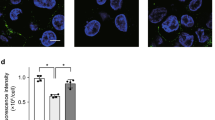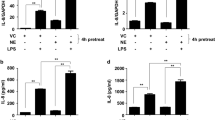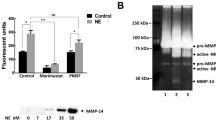Abstract
Interleukin-8 (IL-8) activates neutrophils via the chemokine receptors CXCR1 and CXCR2. However, the airways of individuals with cystic fibrosis are frequently colonized by bacterial pathogens, despite the presence of large numbers of neutrophils and IL-8. Here we show that IL-8 promotes bacterial killing by neutrophils through CXCR1 but not CXCR2. Unopposed proteolytic activity in the airways of individuals with cystic fibrosis cleaved CXCR1 on neutrophils and disabled their bacterial-killing capacity. These effects were protease concentration–dependent and also occurred to a lesser extent in individuals with chronic obstructive pulmonary disease. Receptor cleavage induced the release of glycosylated CXCR1 fragments that were capable of stimulating IL-8 production in bronchial epithelial cells via Toll-like receptor 2. In vivo inhibition of proteases by inhalation of α1-antitrypsin restored CXCR1 expression and improved bacterial killing in individuals with cystic fibrosis. The cleavage of CXCR1, the functional consequences of its cleavage, and the identification of soluble CXCR1 fragments that behave as bioactive components represent a new pathophysiologic mechanism in cystic fibrosis and other chronic lung diseases.
This is a preview of subscription content, access via your institution
Access options
Subscribe to this journal
Receive 12 print issues and online access
$209.00 per year
only $17.42 per issue
Buy this article
- Purchase on Springer Link
- Instant access to full article PDF
Prices may be subject to local taxes which are calculated during checkout






Similar content being viewed by others
References
Holmes, W.E., Lee, J., Kuang, W.J., Rice, G.C. & Wood, W.I. Structure and functional expression of a human interleukin-8 receptor. Science 253, 1278–1280 (1991).
Murphy, P.M. & Tiffany, H.L. Cloning of complementary DNA encoding a functional human interleukin-8 receptor. Science 253, 1280–1283 (1991).
Baggiolini, M. Chemokines in pathology and medicine. J. Intern. Med. 250, 91–104 (2001).
Nathan, C. Neutrophils and immunity: challenges and opportunities. Nat. Rev. Immunol. 6, 173–182 (2006).
Schumacher, C., Clark-Lewis, I., Baggiolini, M. & Moser, B. High- and low-affinity binding of GRO alpha and neutrophil-activating peptide 2 to interleukin 8 receptors on human neutrophils. Proc. Natl. Acad. Sci. USA 89, 10542–10546 (1992).
Wuyts, A. et al. Differential usage of the CXC chemokine receptors 1 and 2 by interleukin-8, granulocyte chemotactic protein-2 and epithelial cell–derived neutrophil attractant-78. Eur. J. Biochem. 255, 67–73 (1998).
Samanta, A.K., Oppenheim, J.J. & Matsushima, K. Interleukin-8 (monocyte-derived neutrophil chemotactic factor) dynamically regulates its own receptor expression on human neutrophils. J. Biol. Chem. 265, 183–189 (1990).
Chuntharapai, A. & Kim, K.J. Regulation of the expression of IL-8 receptor A/B by Il-8—possible functions of each receptor. J. Immunol. 155, 2587–2594 (1995).
Richardson, R.M. et al. Regulation of human interleukin-8 receptor A: identification of a phosphorylation site involved in modulating receptor functions. Biochemistry 34, 14193–14201 (1995).
Richardson, R.M., Pridgen, B.C., Haribabu, B., Ali, H. & Snyderman, R. Differential cross-regulation of the human chemokine receptors CXCR1 and CXCR2—evidence for time-dependent signal generation. J. Biol. Chem. 273, 23830–23836 (1998).
Richardson, R.M., Ali, H., Pridgen, B.C., Haribabu, B. & Snyderman, R. Multiple signaling pathways of human interleukin-8 receptor A. Independent regulation by phosphorylation. J. Biol. Chem. 273, 10690–10695 (1998).
Barlic, J. β-arrestins regulate interleukin-8–induced CXCR1 internalization. J. Biol. Chem. 274, 16287–16294 (1999).
Baggiolini, M., Walz, A. & Kunkel, S.L. Neutrophil-activating peptide-1/interleukin 8, a novel cytokine that activates neutrophils. J. Clin. Invest. 84, 1045–1049 (1989).
Peveri, P., Walz, A., Dewald, B. & Baggiolini, M. A novel neutrophil-activating factor produced by human mononuclear phagocytes. J. Exp. Med. 167, 1547–1559 (1988).
Djeu, J.Y., Matsushima, K., Oppenheim, J.J., Shiotsuki, K. & Blanchard, D.K. Functional activation of human neutrophils by recombinant monocyte-derived neutrophil chemotactic factor/IL-8. J. Immunol. 144, 2205–2210 (1990).
Jones, S.A., Wolf, M., Qin, S.X., Mackay, C.R. & Baggiolini, M. Different functions for the interleukin 8 receptors (IL-8R) of human neutrophil leukocytes: NADPH oxidase and phospholipase D are activated through IL-8R1 but not IL-8R2. Proc. Natl. Acad. Sci. USA 93, 6682–6686 (1996).
L'Heureux, G.P., Bourgoin, S., Jean, N., McColl, S.R. & Naccache, P.H. Diverging signal-transduction pathways activated by interleukin-8 and related chemokines in human neutrophils—interleukin-8, but not Nap-2 or Gro-α, stimulates phospholipase-D activity. Blood 85, 522–531 (1995).
Moepps, B., Nuesseler, E., Braun, M. & Gierschik, P. A homolog of the human chemokine receptor CXCR1 is expressed in the mouse. Mol. Immunol. 43, 897–914 (2006).
Baggiolini, M., Dewald, B. & Moser, B. Interleukin-8 and related chemotactic cytokines—CXC and CC chemokines. Adv. Immunol. 55, 97–179 (1994).
Bonfield, T.L. et al. Inflammatory cytokines in cystic-fibrosis lungs. Am. J. Respir. Crit. Care Med. 152, 2111–2118 (1995).
Stockley, R.A. Neutrophils and the pathogenesis of COPD. Chest 121, 151S–155S (2002).
Roos, D. & Winterbourn, C.C. Immunology—lethal weapons. Science 296, 669–671 (2002).
Pease, J.E. & Sabroe, I. The role of interleukin-8 and its receptors in inflammatory lung disease: implications for therapy. Am. J. Respir. Med. 1, 19–25 (2002).
Konstan, M.W. & Berger, M. Current understanding of the inflammatory process in cystic fibrosis: onset and etiology. Pediatr. Pulmonol. 24, 137–142 (1997).
Daniels, R.H., Finnen, M.J., Hill, M.E. & Lackie, J.M. Recombinant human monocyte IL-8 primes NADPH-oxidase and phospholipase A2 activation in human neutrophils. Immunology 75, 157–163 (1992).
Döring, G. The role of neutrophil elastase in chronic inflammation. Am. J. Respir. Crit. Care Med. 150, S114–117 (1994).
Mayer-Hamblett, N. et al. Association between pulmonary function and sputum biomarkers in cystic fibrosis. Am. J. Respir. Crit. Care Med. 175, 822–828 (2007).
Allen, L. et al. Pyocyanin production by Pseudomonas aeruginosa induces neutrophil apoptosis and impairs neutrophil-mediated host defenses in vivo. J. Immunol. 174, 3643–3649 (2005).
Kobayashi, S.D. et al. Bacterial pathogens modulate an apoptosis differentiation program in human neutrophils. Proc. Natl. Acad. Sci. USA 100, 10948–10953 (2003).
Sabroe, I., Jones, E.C., Whyte, M.K.B. & Dower, S.K. Regulation of human neutrophil chemokine receptor expression and function by activation of Toll-like receptors 2 and 4. Immunology 115, 90–98 (2005).
Pham, C.T. Neutrophil serine proteases: specific regulators of inflammation. Nat. Rev. Immunol. 6, 541–550 (2006).
Berger, M., Sorensen, R.U., Tosi, M.F., Dearborn, D.G. & Doring, G. Complement receptor expression on neutrophils at an inflammatory site, the Pseudomonas-infected lung in cystic fibrosis. J. Clin. Invest. 84, 1302–1313 (1989).
Tosi, M.F., Zakem, H. & Berger, M. Neutrophil elastase cleaves C3bi on opsonized Pseudomonas as well as CR1 on neutrophils to create a functionally important opsonin receptor mismatch. J. Clin. Invest. 86, 300–308 (1990).
Vandivier, R.W. et al. Elastase-mediated phosphatidylserine receptor cleavage impairs apoptotic cell clearance in cystic fibrosis and bronchiectasis. J. Clin. Invest. 109, 661–670 (2002).
Taggart, C.C., Greene, C.M., Carroll, T.P., O'Neill, S.J. & Mcelvaney, N.G. Elastolytic proteases: inflammation resolution and dysregulation in chronic infective lung disease. Am. J. Respir. Crit. Care Med. 171, 1070–1076 (2005).
Khandaker, M.H. et al. CXCR1 and CXCR2 are rapidly down-modulated by bacterial endotoxin through a unique agonist-independent, tyrosine kinase–dependent mechanism. J. Immunol. 161, 1930–1938 (1998).
Akira, S. & Takeda, K. Toll-like receptor signalling. Nat. Rev. Immunol. 4, 499–511 (2004).
Khandaker, M.H. et al. Metalloproteinases are involved in lipopolysaccharide- and tumor necrosis factor-α–mediated regulation of CXCR1 and CXCR2 chemokine receptor expression. Blood 93, 2173–2185 (1999).
Khan, T.Z. et al. Early pulmonary inflammation in infants with cystic fibrosis. Am. J. Respir. Crit. Care Med. 151, 1075–1082 (1995).
Mall, M., Grubb, B.R., Harkema, J.R., O'Neal, W.K. & Boucher, R.C. Increased airway epithelial Na+ absorption produces cystic fibrosis–like lung disease in mice. Nat. Med. 10, 487–493 (2004).
Frizzell, R.A. & Pilewski, J.M. Finally, mice with cystic fibrosis lung disease. Nat. Med. 10, 452–454 (2004).
McElvaney, N.G. et al. Aerosol α1-antitrypsin treatment for cystic fibrosis. Lancet 337, 392–394 (1991).
Stockley, R.A. Neutrophils and protease/antiprotease imbalance. Am. J. Respir. Crit. Care Med. 160, S49–S52 (1999).
Tsang, K.W. et al. Sputum elastase in steady-state bronchiectasis. Chest 117, 420–426 (2000).
Stockley, R.A. The role of proteinases in the pathogenesis of chronic bronchitis. Am. J. Respir. Crit. Care Med. 150, S109–113 (1994).
Ordonez, C.L., Shaughnessy, T.E., Matthay, M.A. & Fahy, J.V. Increased neutrophil numbers and IL-8 levels in airway secretions in acute severe asthma: clinical and biologic significance. Am. J. Respir. Crit. Care Med. 161, 1185–1190 (2000).
Wenzel, S.E. et al. Bronchoscopic evaluation of severe asthma. Persistent inflammation associated with high dose glucocorticoids. Am. J. Respir. Crit. Care Med. 156, 737–743 (1997).
Pignatti, P. et al. Downmodulation of CXCL8/IL-8 receptors on neutrophils after recruitment in the airways. J. Allergy Clin. Immunol. 115, 88–94 (2005).
Panina, P., Mariani, M. & D'Ambrosio, D. Chemokine receptors in chronic obstructive pulmonary disease (COPD). Curr. Drug Targets 7, 669–674 (2006).
van Pelt, L.J. et al. Limitations on the use of dihydrorhodamine 123 for flow cytometric analysis of the neutrophil respiratory burst. J. Immunol. Methods 191, 187–196 (1996).
Acknowledgements
We thank E. Remold-O'Donnell, M. Ennis, J. Elias, C. Sommerhoff, F. Ebel, A. Luster, M. Mall and B. Walzog for helpful discussions, and J. Miller for proofreading. This work is supported by the German Federal Ministry of Education and Research in the program BioFuture FKZ0311898 (C.R.), the German Society of Pediatric Pneumology (D.H.), Präventions-und Informationsnetzwerk Allergie/Asthma e.V. (D.H.) and the German Research Society DFG GR970-7.2 (M.G., M.W.).
Author information
Authors and Affiliations
Contributions
D.H. designed the main research concept, performed experiments and wrote the manuscript. A.A.R., D.R. and M.G. supervised the study, codesigned the research concept and wrote the manuscript; P.L. contributed to study design, performed statistical analyses and wrote the manuscript; D.R. provided funding and cosupervised the project.; P.H., V.M., C.R., M.W., B.K. and S.K.-E. performed experiments and/or provided scientific and technical knowledge.
Corresponding author
Supplementary information
Supplementary Text and Figures
Supplementary Figs. 1–4, Supplementary Tables 1 and 2 and Supplementary Methods (PDF 133 kb)
Rights and permissions
About this article
Cite this article
Hartl, D., Latzin, P., Hordijk, P. et al. Cleavage of CXCR1 on neutrophils disables bacterial killing in cystic fibrosis lung disease. Nat Med 13, 1423–1430 (2007). https://doi.org/10.1038/nm1690
Received:
Accepted:
Published:
Issue Date:
DOI: https://doi.org/10.1038/nm1690
This article is cited by
-
Transcriptome analysis reveals the differential inflammatory effects between propofol and sevoflurane during lung cancer resection: a randomized pilot study
World Journal of Surgical Oncology (2023)
-
The chemokines CXCL8 and CXCL12: molecular and functional properties, role in disease and efforts towards pharmacological intervention
Cellular & Molecular Immunology (2023)
-
Neutrophil chemoattractant receptors in health and disease: double-edged swords
Cellular & Molecular Immunology (2020)
-
Dysregulated signalling pathways in innate immune cells with cystic fibrosis mutations
Cellular and Molecular Life Sciences (2020)
-
Interaction of host and Staphylococcus aureus protease-system regulates virulence and pathogenicity
Medical Microbiology and Immunology (2019)



